There are several different types of computer neurofeedback and programs and equipment used to administer Neurofeedback. The type of equipment and computer protocol used for treatment is chosen by the Clinician. This is based on what they see on the patient’s qEEG Brain map. Different types of equipment hardware and different types of computer software are used to treat different conditions. At ATTN Center, NYC we have clinicians trained in neurofeedback and all that this process entails.
Hardware For Different Types of Neurofeedback Therapy in NYC
Bipolar Montage, free-electrode wires
The most basic setup for Neurofeedback would include 2-8 electrode wires. This setup is called the Bipolar Montage and is used today in Neurofeedback. It uses a thin layer of wax/paste to be applied to the scalp. It’s called the Double Banana Montage, and it’s still in use today.
In a Bipolar Montage, each electrode’s voltage is linked and compared to an adjacent one to form a chain of electrode information. In a Double Banana Montage, each electrode is linked and compared to the one behind it. This forms a banana shape when looking at a chart of the 10-20 sites. In each chain, every tracing line is a pair of electrodes. We subtract the voltage of the second electrode from the voltage of the first electrode.
As a result, you get a positive deflection downward if the first electrode is more than the second. Negative upward deflection occurs when the second electrode is more.
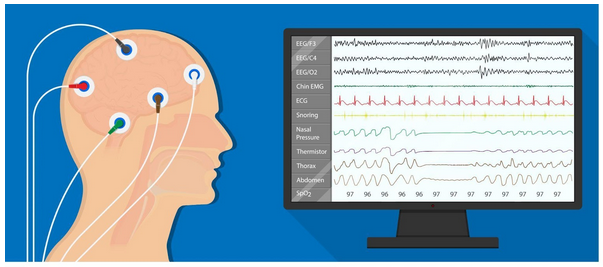
10/20 Montage, Full-Cap Training
First, the most advanced setup will be reviewed, and it would likely have a wet or dry electrode cap. This is because the Clinician would be able to utilize more areas of the brain at once, compared to the limited capacity of a 2-5 electrode setup.
The lycra stretch cap holds 24 embedded silver/silver chloride electrodes pressed closely to the subject’s head. Electrodes are pre-positioned in the international 10/20 montage, so EEG clinicians can easily reduce electrode placement errors. A 100 cm long rainbow ribbon cable has connectors fanned out in the cap to connect each electrode to the computer for observation. The electrode cap’s connector arrangement allows the electrode cap to be easily disconnected from the amplifier. This allows the cap to be fitted in one location and used in another. They range in sizes based on age, from infant to large caps.
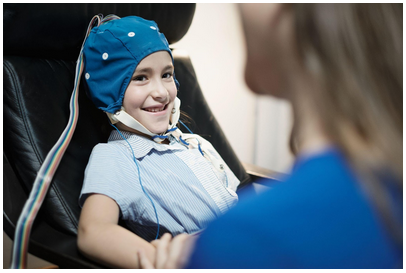
EEG Amplifiers for Different Types of Neurofeedback Therapy
Amplifiers come in all shapes and sizes. They’re too many to list here. Depending on your treatment needs, you’ll get an amplifier from your Neurofeedback clinician. We use CGX amplifiers and Brainmaster’s Discovery system at ATTN.
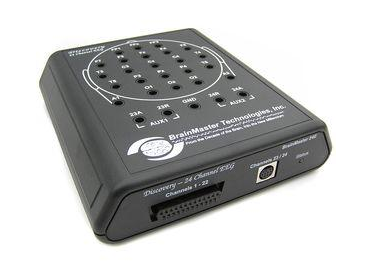
The amplifier is a small box that monitors your brainwaves. One end of the amplifier connects to the electrode cap with the rainbow ribbon cable, and the other end connects to the computer to run the software. Microsecond-to-microsecond changes in EEG information are processed by the amplifier and sent to the computer for processing by the software. There are amplifiers that allow you to connect the free electrodes directly to the top, and there are other amplifiers that require the rainbow ribbon. There are some that offer both.
Software
Frequency/Power Neurofeedback
One of the most commonly used types of neurofeedback is frequency/power neurofeedback. Two to four electrodes are applied to a specific site on the head that has been shown to be problematic in brain mapping. At the sites, specific brainwaves/frequencies are chosen to be uptrained or down-trained (depending on whether you produce too little or too much of a specific brainwave). Therefore, once these frequencies have been regulated, most clients report reduced symptoms of why they sought out treatment in the first place (ADHD, anxiety, depression, OCD, sleep, etc.)
What is Frequency?
Frequency indicates how fast the waves oscillate, which is measured by the number of waves per second (Hz), while amplitude represents the power of these waves measured by microvolt (µV). Fast Fourier transformation shows numeric values decomposing the waves into the voltage of each frequency which provides power spectrum data driven from qEEG analysis are the following: spectral analysis (frequency composition over a given time); absolute power (the square of the EEG amplitude, mathematically indicates the strength of the signal at the given frequencies interval); and coherence (analogous to cross-correlation in the frequency domain between activity in two channels).
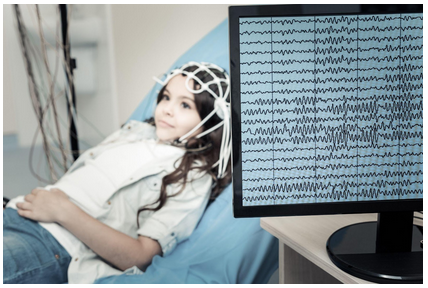
Frequency Training
In Frequency training, self-regulation of specific aspects of electrical brain activity is acquired by means of immediate feedback and positive reinforcement. This means that in frequency training, activity in different EEG frequency bands has to be decreased or increased. Neurofeedback studies have revealed effects on attention and memory processes and performance improvements in real-life conditions. In addition, many studies have shown that children with attention deficit hyperactivity disorder (ADHD) improved behavioral and cognitive variables after frequency training. There is growing evidence for neurofeedback as a valuable treatment module in different neuropsychiatric disorders, as well as for better achievement in school and sports.
LORETA Neurofeedback
A more advanced version of Neurofeedback is sLORETA neurofeedback. LORETA incorporates frequency/power neurofeedback into it and includes a few more elements.
Traditional frequency/power types of neurofeedback reads brainwaves being emitted at the surface of the scalp/cortex and bases treatment on this. LORETA (low-resolution electromagnetic tomography) neurofeedback uses an algorithm to convert raw surface EEG signals into 3D LORETA images.
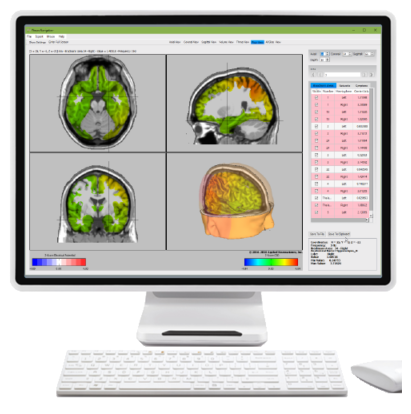
3D Depiction of The Brain
This creates a 3D depiction of the brain, allowing treatment to go beyond surface training and target areas not discovered by surface-level treatment. The brain is more accurately defined in LORETA training. This includes 3D regions like the amygdala, thalamus, hippocampus, cerebellum, and segments called Brodmann areas that cover the whole brain. In addition to the training of the frequency/power of these brain regions, LORETA neurofeedback also helps train something called coherence and phase.
Moreover, rather than focusing on the activation/inhibition of brain waves like frequency/power training does, coherence focuses on the amount of communication happening between different regions of the brain. All the different regions of the brain (amygdala, thalamus, etc.) communicate with each other. Sometimes they are communicating too much or too little with each other. LORETA neurofeedback can detect problem areas of coherence and help train them toward balanced communication and synchronicity.
What is Phase?
Phase refers to the ability and speed of energy in one part of the brain to move and arrive at another part of the brain in a timely manner to complete a specific task. For example, someone who has OCD experiences phase issues. In other words, they get stuck on a task and are unable to complete it in a timely matter. This is because the phase is out of sync.
By regulating phase through LORETA neurofeedback, the brain can learn to function in a more efficient manner reducing symptoms related to phase dysfunction. In other words, the combination of frequency/power training, coherence training, and phase training makes LORETA neurofeedback a very powerful intervention. It is a full cap (19 channels or more) and learned through Z-score training.
Z-score training
In effect, the client’s brainwaves are compared to a normative database of brainwaves (a group of people the same gender and age as the client who doesn’t suffer from any form of ADHD, OCD, Depression, Sleep disorders, etc.). They are then trained toward this normative database.
Operant Conditioning
The training happens through operant conditioning- usually, the client will watch a movie or screen during the session and is rewarded every time their brain is functioning closer to the norm through the screen going bright. When their brain is not doing what it needs to do and is deviating from the norm, the screen goes dim.
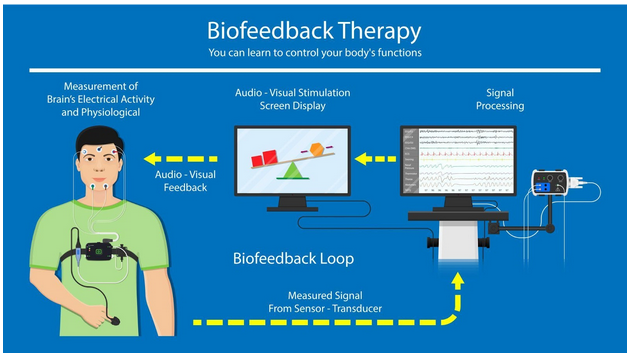
Over time and with enough sessions, the brain learns how to regulate and obtain more rewards- making the screen become bright and more. In most cases, once brain regulation is learned (the amount of time this takes depends on the severity of the case), the brain no longer needs the screen and sessions to function optimally (aside from the occasional tune-up session).
Explore Types of Neurofeedback Therapy in New York
If you are struggling and feel that neurofeedback therapy in NYC may be the perfect answer we are here to help guide you on this journey! Retrain your brain using the latest cutting-edge technology with the guidance of our trained therapists at ATTN Center!
We are here to help mitigate the negative aspects of ADHD symptoms and related issues such as ADHD-related depression and anxiety. As well as to help you tap into the strengths and benefits of ADHD in order to use it as your superpower! Below is a list of simple steps to follow to get started on this journey:
Firstly, Learn more about our team and the services offered here!
Secondly, Reach out to us through our convenient online therapy contact page here!
Thirdly, Begin the journey to understanding your diagnosis and living your best life!
Other ADHD Services Offered by The ATTN Center in NYC
We not only offer different types of neurofeedback therapy, but also other services related to the treatment of ADHD and its side effects. Because of that, this includes therapy for ADHD-related anxiety and depression, group therapy, and ADHD testing options. At ATTN Center of NYC, we do everything in our power to treat ADHD without the use of medication through our ADHD-focused therapy services. But we understand in some severe cases additional measures may be needed. As a result, we also maintain close relationships with many of NYC’s best psychiatrists. In other words, whatever you need- we are here to help. Above all, your care is the most important thing to us.
References
Balt, K., Du Toit, P. J., Smith, M., & Janse van Rensburg, C. (2020). The effect of infraslow frequency neurofeedback on autonomic nervous system function in adults with anxiety and related diseases.
Biswas, A., & Ray, S. (2019). Alpha neurofeedback has a positive effect for participants who are unable to sustain their alpha activity. ENeuro, 6(4).
Dong, Y. (2020). Auditory Neurofeedback for Noise Suppression and Speech Enhancement (Doctoral dissertation, Saint Louis University).
Gong, Anmin, et al. “Efficacy, trainability, and neuroplasticity of SMR vs. Alpha rhythm shooting performance neurofeedback training.” Frontiers in Human Neuroscience 14 (2020): 94.
Kopřivová, J., Congedo, M., Raszka, M., Praško, J., Brunovský, M., & Horáček, J. (2013). Prediction of treatment response and the effect of independent component neurofeedback in obsessive-compulsive disorder: a randomized, sham-controlled, double-blind study. Neuropsychobiology, 67(4), 210-223.
Liu, Yisi, Olga Sourina, and Xiyuan Hou. “Neurofeedback games to improve cognitive abilities.” 2014 International Conference on Cyberworlds. IEEE, 2014.
Marzbani, H., Marateb, H. R., & Mansourian, M. (2016). Neurofeedback: a comprehensive review on system design, methodology and clinical applications. Basic and clinical neuroscience, 7(2), 143.
Pei, G., Wu, J., Chen, D., Guo, G., Liu, S., Hong, M., & Yan, T. (2018). Effects of an integrated neurofeedback system with dry electrodes: EEG acquisition and cognition assessment. Sensors, 18(10), 3396.